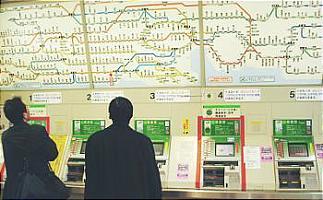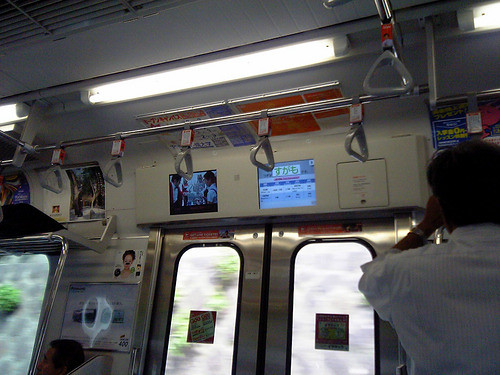Photo from: Travel Pod
No doubt you've heard all about Tokyo train stations. The horror stories of how busy they are, how confusing the maps are, how people get pushed onto rush hour trains. Forget all of your preconceptions - Tokyo has possibly the most efficient train station in the world, and as Japanese spend a large portion of their time in the stations they can be a pretty nice place to be, with shops, restaurants and izakayas and almost always feature signs in both Japanese and English.
The most important line you need to know about is the Yamanote line - which is Tokyo's busiest commuter rail line. The Yamanote is recognisable by the green train cars, and travels in a big loop around Tokyo's most important destinations, such as Shinjuku, Shibuya, Harajuku and Ikebukuro. The trains run every 2.5-4 minutes and are consistently on time. Once onboard you can follow the stops by means of small TV screens over every door. Each station is also announced and features its own short jingle - which seems to rouse fast asleep Japanese communters quicker than a slap in the face (not that we've tried this!).
So now you know a little bit about the trains it's time to...
Buy A Ticket
The best was to buy a train ticket (unless you are planning on riding the shinkansen, or going quite far afield) is the ticket vending machines.
Photo from: Japan Guide
Above the ticket machines is a station map, in both Japanese and English, you need to locate your station (if you are travelling on the Yamanote line - it's the green loop) and just below the station name you can find the price. You then put in the money for your fare (don't worry - the machines give change!), pick the number of travellers (the default is one), press the button for the correct fare and your ticket/s will be spat out.
You can also visit the manned ticket counter, however as Japanese pronunciation can be difficult this can sometimes be more complicated than the machine.
After buying a ticket, you are ready to...
Go Through The Paid Gate
Every station that I have visited in Tokyo - including some of the smaller ones - have an automatic ticket gate, with one manned cubicle. To get through the automatic gate you need to feed your ticket into the slot in the machine, at which point the gates will open, when you pass through remember to grab your ticket on the other side of the gate as you will need it to exit the train!
The Platform
Finding your gate is generally very simple as all signage is in both Japanese and English - once on the platform you can grab a drink or snack from one of Tokyo's many vending machines or platform counters. You should then take notice of the markings on the ground - which will mark the position of the doors when the train pulls into the station - once again very efficiently.
Photo by: Travel Pod
Riding The Train
Once onboard the train take a seat - if there is one! (most Japanese trains have sideways facing seats - so watch out for napping communters who decide your shoulder looks like a comfortable place to rest!) On popular tourist lines - like the Yamanote - station announcements will be made in Japanese and English. If you are on a smaller, more local line then just keep an eye out for the station signs as these will show the station name in English.
Photo from: Balvig
Once You Arrive
After departing the train leave the platform, make sure you know which exit you need to use - as the myth about Japanese train stations being huge is generally true! Leaving the station by the wrong gate can lead to a lot of confusion and often ends with you getting really lost. All exits are well signposted so if you know which one you want it's really not so difficult. Leave through the automatic gates by placing your ticket in the slot - just like you did to access the platform - but this time it won't be spat out. And that's it - you're out and about and free to explore the fab stalls, shops and food places in the stations.









0 comments:
Post a Comment